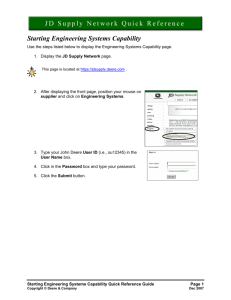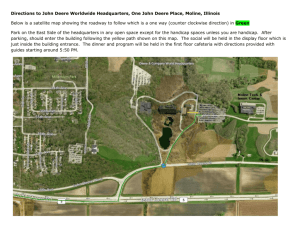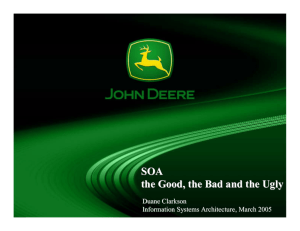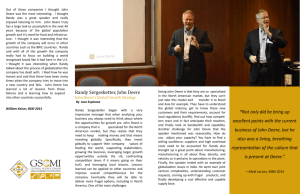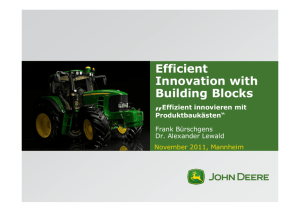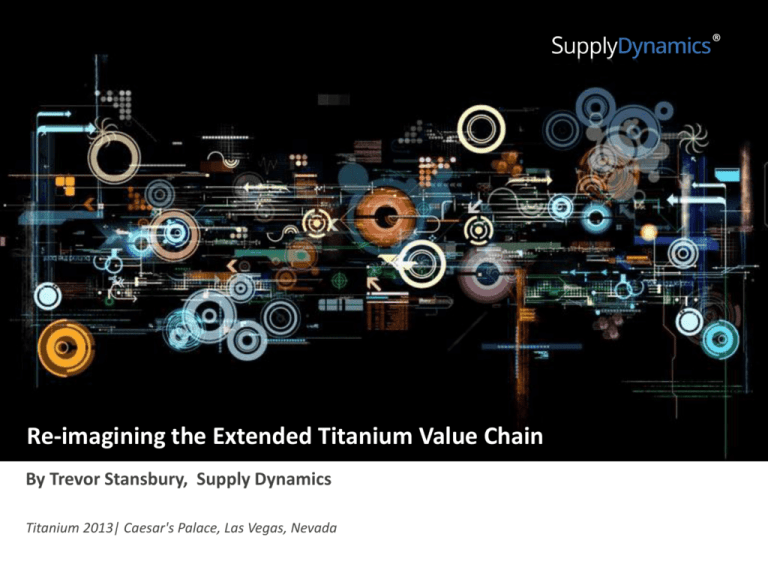
®
Re-imagining the Extended Titanium Value Chain
By Trevor Stansbury, Supply Dynamics
Titanium 2013| Caesar's Palace, Las Vegas, Nevada
What do titanium and watermelon have in common?
“Points of pain” transformed…
…into “points of infatuation”
VOLATILITY
+
OUTSOURCING
+ GLOBALIZATION
Cost & demand variability
Less control of critical cost drivers
Highly distributed supply base
Supply disruptions
Fragmented purchasing power
Extended planning horizons
Reduced productivity
Supplier financial instability
Operating model complexity
= RISK, threatening revenue, earnings certainty &
customer satisfaction
The Environment
Copyright © 2003-2013 Supply Dynamics LLC. All rights reserved.
4
“The most important information is not
what goes on inside the organization
but what goes on outside, and that
information is not available and in most
cases doesn’t exist.”
-Peter Drucker
BBC World Series Nov. ‘05
The problem of “data dislocation”
Tier 2
OEM
4
Tier 3
Contract
Manufacturer
B
Contract
Manufacturer
A
Distributor
A
Tier 2
Distributor
B
Mills
Tier 3
4
Copyright © 2003-2013 Supply Dynamics LLC. All rights reserved.
6
Problem: Data ‘gaps’ put your Supply Network at risk.
Copyright © 2003-2013 Supply Dynamics LLC. All rights reserved.
7
Why is this important?
Copyright © 2003-2013 Supply Dynamics LLC. All rights reserved.
8
Too much focus on operational elements of ‘should cost’
analysis . . . and not on Material inputs
30 to 60 % Cost Driver
© 2013 Supply Dynamics. All rights reserved.
9
Global OEM’s* recognize the challenges . . .
John Deere purchases raw materials and some manufactured components and
replacement parts for its equipment, engines and other products from leading suppliers
both domestically and internationally. These materials and components include a
variety of steel products, steel and iron castings, forgings, plastics,
electronics and ready to assemble components made to certain
specifications. John Deere also purchases various goods and services used in
production, logistics, offices and research and development processes. John Deere
maintains strategic sourcing models to meet its production needs and build upon longterm supplier relationships. John Deere uses a variety of agreements with suppliers
intended to drive innovation, ensure availability and delivery of industry-leading quality
raw materials and components, manage costs on a globally competitive basis,
protect John Deere’s intellectual property and minimize other supply-related risks. Supply
chain risks monitored by John Deere to minimize the likelihood of the supply base
causing business disruption include supplier financial viability, capacity,
business continuity, quality and delivery, and weather-related events including
natural disasters. In fiscal year 2012, John Deere experienced no significant work
stoppages as a result of shortages of raw materials or other commodities
* Excerpt from John Deere 2012 10K
Copyright © 2003-2013 Supply Dynamics LLC. All rights reserved.
10
. . . & exposure to Risks* that can impact earnings certainty
Changes in the availability and price of certain raw materials, components and whole
goods could result in production disruptions or increased costs and lower profits on sales
of John Deere products. John Deere requires access to various raw materials, components
and whole goods at competitive prices to manufacture and distribute its products.
Changes in the availability and price of these raw materials, components and
whole goods, which have fluctuated significantly in the past and which are more likely to
occur during times of economic volatility, can significantly increase the costs of
production which could have a material negative effect on the profitability of the business,
particularly if John Deere, due to pricing considerations or other factors, was unable to
recover the increased costs from its customers. John Deere relies on suppliers to
acquire raw materials, components and whole goods required to
manufacture its products. Certain components and parts used in John Deere’s
products are available from a single supplier and cannot be re-sourced quickly. Supply
chain disruptions due to supplier financial viability, capacity constraints,
business continuity, quality, delivery, or disruptions due to weather related or natural
disaster events could affect John Deere’s operations and profitability.
* Excerpt from John Deere 2012 10K
Copyright © 2003-2013 Supply Dynamics LLC. All rights reserved.
11
The more
D I S T R I B U T E D
and E X T E N D E D your Supply Network becomes,
the stronger its management needs to be.
Copyright © 2003-2013 Supply Dynamics LLC. All rights reserved.
12
A Business Imperative
Re-capturing visibility & control . . .
1
Reconnect your assembly and part schedules to a detailed breakdown of
the components and raw materials that go into them
EXTENDED SUPPLY NETWORK
MATERIALS
2
PARTS
COMPONENTS
OEM
ASSEMBLIES
FINISHED GOODS
Influence & control supply, and proactively coordinate critical constraints
on behalf of your Supply Network.
Copyright © 2003-2013 Supply Dynamics LLC. All rights reserved.
13
Prerequisite: An Analytic, Collaborative Multi-Enterprise Platform
The best solutions:
•
Establish one system of TRUTH.
•
Automate Bill-of-Material maintenance and up-keep.
•
Empower multi-enterprise collaboration between
stakeholders.
•
Provide secure role-based access to Stakeholders via the
‘cloud’ and presented relevant views to what matters.
•
Allow validation of information, and customized reporting
based upon the participant’s role.
•
Interface seamlessly with but do not require changes to OEM
legacy systems.
•
Enable real-time monitoring & reporting on purchasing and
delivery status across the extended enterprise.
Value drivers. Risk mitigation + reduction of COGS
Strategies supported reduce financial exposure + deliver hard $ savings
Value
Description
Leverage aggregate volume to gain commercial benefit with producer
DEMAND
AGGREGATION
NETWORK
COLLABORATION
Standardize production material forms, sizes and specifications
Proactively expedite the timely purchase and supply of production materials
across the extended supply network
Eliminate sole sources of supply
Recover ‘cost of credit’ premium (estimated at +/- 7 pct – sub-tier risk)
NETWORK
VISIBILITY
‘Price masking vs. Directed buy benefit / Capture Rebate
Improved forecasting & planning
Compress & control cash conversion cycle
CREDIT
ARBITRAGE
Ensure continuous supply and capacity
Better manage and monitor surcharges
COMPLEXITY
REDUCTION
Reduce Part & Commodity Complexity
Recover scrap/revert value
QUALITY &
COMPLIANCE
Reduce delivery variances through better coordination
Analytics drive commodity strategies & sourcing policies
1
OASIS 8.0 GENERATES ‘BILL
OF RESOURCE’ ANALYTICS
2
MAP ANALYTICS TO VALUE
DRIVERS & RISK FACTORS
3
EVALUATE SAVINGS AGAINST
SOURCING POLICY CRITERIA
BUY-SELL
(RESALE)
NETWORK
STAKEHOLDERS
MARKET
VOLATILITY
NETWORK
DEMAND
DEMAND
AGGREGATION
COMMODITY
CATEGORY
PHYSICAL
FLOW
STRATEGY
& EXECUTION
MODEL
DIRECTED
BUY
REBATE
(DIRECTED BUY)
CONSIGNMENT
(BUY & CONSIGN)
Wrap Up & Summary
Thank you!
For additional information or to learn more about Supply Dynamics & how we can help transform your Extended
Supply Chain into a sustainable competitive advantage please contact us: by phone at +1 (513) 965-2000, e-mail
results@supplydynamics.com or visit www.supplydynamics.com
Copyright © 2003-2013 Supply Dynamics LLC. All rights reserved.
18
About Us . . .
Supply Dynamics was conceived and built from the ground up specifically to
address the challenges of managing sourcing, procurement and supply chain
complexity in highly distributed manufacturing environments.
Our solutions were designed to reflect a deep focus on the multi-tier, multienterprise relationships between parts, materials, capacities, processes and
finished goods.
We work with leading Fortune 1000 global manufacturing companies that
are committed to pro-actively managing part-commodity supply risk and
price volatility throughout their extended network of external partners and
suppliers. Our clients recognize the value of our data driven approach &
solutions as a sustainable competitive advantage.

